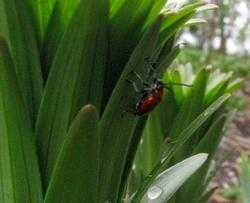Lily Leaf Beetle

Gary Westlake
All you folks out there whose lilies are slimy sticks with only a few leaves left, chewed beyond recognition need to give up. In case you have not noticed, there is a little red beetle that is turning your lily garden into its own personal smorgasbord. Its too late for you but the rest of us just might be able to save our lilies, if you stop breeding them and releasing them into the neighbourhood.
This bright red beetle looks like a stretch limo ladybug without any spots. Its young are disgusting because they live under the leaves and keep their black gooey excrement on the their backs while chewing the leaves. In the early spring the adults that have made it through the winter, start crawling around the dead leaves and mulch in your garden looking for lilies to ravage. They also fly over to our gardens and lay their tiny brown eggs on the lilies there.
If you are not prepared to do a bit of work, then stick to daylilies that are just about carefree and are not eaten by this little red pest. True lilies look more like the familiar Easter Lily and come in many colours including red, orange, yellow, pink and white. They are all beautiful, and if you plant several varieties, you can have lilies through a good part of the summer. There are a number of wonderful types. There are the earlier flowering asiatic lilies, oriental lilies, and the tall often fragrant trumpet lilies. Lily beetles will also eat fritillaria that is also a beautiful plant.
If, on the other hand, you want to be serious about growing lilies, there is a great reward for the work you have to do. In the early spring when you get the odd warm day, you need to go out into the garden particularly where you grew lilies but also in other areas and look for the red adult beetles. If you find them, squish them with your fingers. Gloves help for this because they leave a stain. They also sometimes give a little squeak when you catch them but ignore this and eliminate this nasty little critter. For every one you catch at this time of year, you have removed hundreds of their potential offspring that would munch on your lilies later in the summer. If you donít want to get your hands messed up, then drop them into soapy water. Once the lilies start growing, they will be found mostly on the leaves of the lilies but sometimes on other plants in the area, and you need to patrol almost daily for them. Once the population gets out of control, itís hard to stop it. Spraying has only limited effect on them because you have to actually get the spray on the beetle. Here is a hint about stalking the adults Ė when your shadow goes over them, they have a tendency to drop to the ground as a defense mechanism.
It was once thought that a product called Neem oil when sprayed on the leaves made the leaves unpalatable to the beetles, but this is not proven and is unlikely. Neem oil will kill on contact but this would not be any better than insecticidal soap. We have had success growing many lilies, by hand picking lily beetles.
Now for the really disgusting part of the task - the young larvae are found under the leaves wallowing in their own black grunkie. If you have a strong constitution, I guess you could pick them off, but we prefer to consider the leaf as a right off. We pick it off and step on it.
The lily beetle is thought to have been imported on lilies from other locations so do not share your lilies to people that donít have lily beetle.
If you are not prepared to do the time, please give up and grow something else. Once the beetles have turned your lilies into dead sticks, they are flying all over town searching for lilies to eat. But if you are willing to take the time to do the work, lilies are some of the most rewarding plants to grow in your garden.